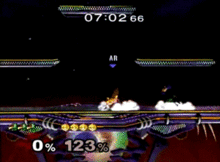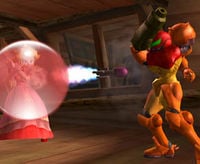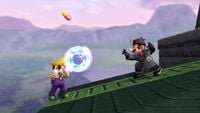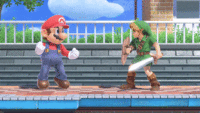| Welcome to SmashWiki! Log in or create an account and join the community, and don't forget to read this first! |
| Notices |
|---|
| The Skill parameter has been removed from Smasher infoboxes, and in its place are the new "Best historical ranking" and "Best tournament result" parameters. SmashWiki needs help adding these new parameters to Smasher infoboxes, refer to the guidelines here for what should be included in these new parameters. |
| When adding results to Smasher pages, include each tournament's entrant number in addition to the player's placement, and use the {{Trn}} template with the matching game specified. Please also fix old results on Smasher pages that do not abide to this standard. Refer to our Smasher article guidelines to see how results tables should be formatted. |
| Check out our project page for ongoing projects that SmashWiki needs help with. |
Perfect shield
A perfect shield (ジャストシールド, Just shield) (officially called the Power Shield in Melee) is a technique where one activates a full shield such that it connects with an incoming attack on the first few frames. In order for the technique to be executed, one must rely on timing and skill. When the opponent is ready to strike, the player must quickly use the shield. If done correctly, the character takes no shield damage (or shieldstun if a projectile was powershielded) and may immediately perform a counterattack while the attacker is stuck in hitlag. The powershield technique in Melee, Brawl, Smash 4, and Ultimate is comparable to a parry in traditional fighting games, as it results in little to no knockback and freezes the opponent for a couple frames.
Perfect shielding up until Smash 4 is done by quickly and fully depressing a shield button four frames before an attack connects. If done correctly, there will be a significant flash on the shield and a distinctive "chlink" sound (with the exception of Smash 4, where a softer sound plays instead). Because it is technically a shield, it is ineffective against grabs and unblockable attacks. In Melee, powershielding can reflect projectiles during the first two frames, although they deal half their usual damage (unlike other reflectors, which increase their damage), and Poké Balls reflected this way retain the ownership of the character that threw them. In Brawl and Smash 4, perfect shielding merely redirects projectiles at an angle without changing their ownership.
In Ultimate the method has been reversed: after a shield has already been raised, perfect shielding is done by releasing the shield button immediately before an attack connects. If performed correctly, the defending character flashes, and both characters (if the attacking character uses a melee attack) enter hitlag, but the defending character is still able to recover much quicker for a counterattack.
CPU players, especially at level 9, use this technique a lot to reflect projectiles in Melee, and against any oncoming attack since Brawl. It is not used often by human players due to the reaction times and precision usually required, and as such, it often comes as a surprise and can momentarily disrupt a match. However, it has been made easier to take advantage of in Brawl onwards than in Melee due to the ability to drop one's shield faster. At high level play, powershielding in Melee can be used to reflect a wave of incoming projectiles such as Falco's laser, to punish camping.
In Super Smash Bros. Melee
In Melee, the technique is known as power shielding (named for the Power Shielder bonus attained by using the technique multiple times). Power shielding is accomplished by fully pressing L or R such that the shield appears just before the incoming attack hits the player. More specifically, the full shield bubble's inner reflection hitbox[1] must connect with the hitbox of the incoming attack within 4 frames of activating the shield[2]. The noise heard by doing this is rather quiet compared to Brawl's, and should a projectile hit on frames 1 or 2 of the powershield, the technique will reflect projectiles at half the original damage. Though the technique is difficult to perform consistently, powershielding is extremely valuable in competitive play, as it allows players to punish moves with low ending lag such as Fox's neutral aerial. Its ability to reflect projectiles is even more valuable as it allows players to punish otherwise safe, predictable projectile spam, particularly in the Falco matchup, whose lasers can shut off many options and leave a player completely helpless if not dealt with properly.
Though extremely difficult, powershielding projectiles is still humanly possible to perform consistently. Players who use characters with projectiles often have an easily trackable firing pattern, such as firing projectiles only when there is a certain distance between the players. It is also important to note that players (again, Falco mains in particular) will short hop to move while firing. As such, a projectile user running or jumping away from pressure is often a surefire sign they intend to fire. If the projectile is thin like Falco's laser, another thing a player can do to ease the risk and timing needed to powershield is to crouch and wait for the projectile to pass over the character. Shielding while the projectile is directly over the character will ensure a powershielded projectile.
Powershield follow-up is also distance dependent. A laser is considered safe if fired when Falco and his opponent are standing a distance X between each other, where X is the max horizontal distance Falco can jump in 1 short hop. At this distance, powershielding the lasers yield no follow ups and attempting to move around them by jumping, rolling, or going under them with attacks that lower hurtboxes (like Marth's dash attack) put the opponent in positions Falco has an easier time winning neutral in. However, if the laser is fired too far away, for example at distance 1.5X, the laser is not safe, as powershielding does yield follow-ups such as a grab.
Due to quirks in Yoshi's shield, Yoshi sometimes powershields attacks even when the shield is already up[3]. This however only works against melee attacks, not projectiles.
Chronological frame data
By pressing L or R during an actionable grounded frame, the Guard animation will be triggered immediately. The ability to powershield with it depends on whether the button press was digital or analog:
1. Digital
GuardReflect is triggered. Reflecting projectiles is possible during the first two frames. During the first four frames, physical attacks will enable the subsequent cancellation of the GuardOff animation. Both are only possible if the incoming hitbox also overlaps the inner powershield sphere on the first frame of its collision with the shield.
- 1.1 If a projectile collides with the powershield sphere during the first two frames, it will get reflected. This has no effect whatsoever on the GuardReflect animation – it will play on just as if nothing had hit the character or his shield. Thus, physical powershields are still possible after a projectile has been powershielded.
- 1.2 If a physical hitbox collides with the powershield sphere during GuardReflect 1-4, the powershield sound and graphical effects are played and the GuardOff cancellation is stored.
- 1.2.1 If the first physical powershield was triggered before the 4th shield frame, subsequent hits up until the 4th shield frame will trigger the sound and graphical powershield effects once more. This does not provide an additional benefit, though.
- 1.2.2 If GuardDamage (the animation usually referred to as shieldstun) is interrupted by another hitbox colliding with the shield, the shielding character undergoes shield hitlag and subsequent shieldstun once more. This does not affect the eventual ability to interrupt GuardOff, even if the shielding character get hits by many attacks while in shield and experiences very long shieldstun.
- 1.2.3 As soon as GuardDamage is over, the character will enter his indefinite Guard animation if he still holds down a shoulder button. If he doesn't keep L, R or Z pressed, he will enter the GuardOff animation.
- 1.2.3.1 If the character immediately transitioned from GuardDamage to GuardOff or didn't spend more than 3 frames in the Guard animation before dropping his shield, the possibility to cancel GuardOff will still be available. GuardOff has a total animation length of 15 frames and can be interrupted by any action that can be triggered with the buttons A, B, X, Y and Z as well as with the C-stick. Additionally, grabbing with (L∨R)∧A, jumping with ↑ and spot dodging with ↓ on the control stick are possible.
- 1.3 If a projectile connects with the powershield sphere during GuardReflect 3-4, the next incoming physical attack will be powershielded. (Details still left to figure out.)
2. Analog
GuardOn is triggered. This animation has no powershield sphere, but the shield sphere is active from the first frame on as well. It can be transitioned to GuardReflect by a digital shoulder button press only on frame one and only if no hitbox collided with the shield on this first frame.
- 2.1 If a digital press occurs before GuardOn 2, the GuardReflect animation will deviate from its normal behavior. During its first two frames, only projectiles are shielded (and reflected). Physical attacks hit the character just as if he wasn’t shielding at all. On GuardReflect 3-4, both the normal shield sphere and the powershield sphere are active.
Example of multi-hit attacks that still preserve the physical powershield benefit
Fox stands in front of Marth and does a SHFFL down aerial:
- AttackAirLw 5: First active frame of Fox's dair. On this frame, Marth presses R digitally and immediately triggers a powershield. This frame is then repeated three times ("hitlag") during which Marth may use shield smash DI.
- AttackAirLw 6: The initial dair hitbox is still active. Because Marth's shield has already been hit by it, there is no collision on this frame.
- AttackAirLw 7: No hitbox is out on this frame. Marth is still in shieldstun.
- AttackAirLw 8: The second kick hitbox comes out. Because this is still the 4th frame of Marth's GuardReflect (the entire shield hitlag is counted as only one frame), the powershield sound and graphical effects are triggered again.
- Later kick hitboxes cause normal shield hitlag and hitstun without the powershield effects.
- After Fox lands on the ground, Marth will transition into GuardOff if he does not press any shoulder buttons anymore and can cancel it after GuardOff 0 with any ground attack. If he still holds L/R down after GuardDamage, he needs to let go after 3 frames of Guard in order to not lose the cancellation option.
- Here, up tilt was not an optimal choice, as on the frame its hitbox came out, Fox was just out of landing lag and could have shined. If he had done so, it would have collided with the up tilt hitbox, so Marth would still not have got hit.
In Super Smash Bros. Brawl
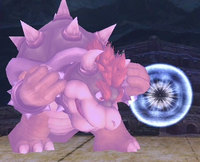
The ability to powershield returns in Brawl, now officially known as a perfect shield. It works similar to Melee, but with a few notable differences. One major change is that perfect shielding no longer reflects projectiles; should a projectile connect during perfect shield frames, it will either disappear or rebound off the shield at an angle instead of back in the direction it came from. A projectile that bounces off a character's shield can no longer affect that character unless it is a multi-hit attack. Additionally, perfect shielding a melee attack now incurs decreased shieldstun, and significantly less shield pushback, decreasing it by 0.15×. Lastly, a clear "clang" sound occurs when a perfect shield is executed.
In Super Smash Bros. 4
In Smash 4, perfect shielding initially worked the exact same way as in Brawl. As of update 1.1.1, however, its action time was reduced from 4 frames to 3 frames, making it more difficult to perform. In return, it decreases damage in the shieldstun formula by 0.66×, compensating for the increased shieldstun in said update and making it more rewarding when executed effectively. Perfect shielding in Smash 4 also produces a quieter sound effect than in Brawl; Ryu is an exception to this, as he instead uses a unique perfect shield sound effect based on the parry in Street Fighter III: 3rd Strike.
Certain equipment has special effects for perfect shields. The Easy Perfect Shield effect widens the window for performing a perfect shield, while the Explosive Perfect Shield effect causes them to create a small, damaging explosion.
In Super Smash Bros. Ultimate
Perfect shielding in Super Smash Bros. Ultimate functions completely differently than in previous games. It now requires the player to release the shield button when an attack connects against their shield, instead of the other way around. It is also significantly more dramatic upon activation: it creates a much brighter flash from the perfect shielder, causes their eyes to glow yellow, and they perform a unique animation while the sound effect produced is louder like in Brawl. Ryu keeps his unique sound effect and now shares it with Ken. Due to these properties, the perfect shield in Ultimate is usually referred to as a parry by the Smash community.
Perfect shielding is activated during the first 5 frames of a character's shield drop animation, which lasts 11 frames (up from Smash 4's 7 frames). The shield has to be put up for at least 3 frames before it can be dropped, essentially causing the technique's earliest possible activation to be 4 frames upon shielding. As a result, while it has a larger window, it can no longer be done immediately, and is less likely to be activated unintentionally, thus carrying more risk. However, unlike in previous games, the radius of a perfect shield does not shrink in proportion to the character's shield, and instead always matches the size of a full shield, increasing its consistency.
Perfect shielding gives different amounts of extra hitlag to the attacker and defender, with intangibility for the defender. Depending on whether a perfect shielded attack is a projectile, and direct or indirect (determined by the attack's hitbox scripts), it has several outcomes:
- For direct non-projectile attacks, the attacker experiences 14 extra frames of hitlag, while the defender experiences 11 extra frames. As a result, the defender can act 3 frames earlier than shielding the attack normally. Although this difference in itself is minimal, perfect shielding still lets the user bypass shield drop lag with any attack like in previous games (compared to only aerial attacks, up smash, and up special), which is a more valuable attribute in Ultimate due to it having been increased, making perfect shielding much more advantageous for punishing usual direct attacks than shielding normally.
- For indirect non-projectile attacks (such as Zero Suit Samus's down smash, Mii Gunner's back aerial, and Bayonetta's smash attacks), the attacker experiences 14 extra frames of hitlag, and the defender experiences only 2 frames more. This allows the defender to act 12 frames earlier than shielding it normally, leaving these moves even more punishable by perfect shielding.
- For direct projectile attacks (such as Isabelle and Snake's up smashes), the attacker is not affected, while the defender experiences 8 extra frames of hitlag. This causes the user to act 8 frames later by comparison, making perfect shielding strictly worse for punishing these attacks than normal shielding.
- For indirect projectile attacks (usual projectiles), the attacker is not affected, while the defender experiences 1 frame less of hitlag. As a result, like with direct attacks, perfect shielding traditional projectiles offers an advantage over shielding them normally, albeit not as significant.
Prior to update 9.0.0, perfect shielding's advantage against both direct and indirect projectiles was 3 frames lower, so that the user could act 11 and 2 frames later (respectively) than shielding them normally, making it less effective against camping. Although update 3.0.0 allegedly increased these advantages to match the current versions, which was (vaguely) documented on Nintendo's official patch notes, it was discovered nearly a year after the update that these changes only applied to Training mode, and were thus irrelevant in competitive play; it was not until 9.0.0 that they applied to every game mode.
With perfect shielding now being tied to the shield drop animation, certain limits have been implemented to it. If an attack is shielded normally, perfect shielding is disabled on a subsequent shield drop unless it is done at least 3 frames after shieldstun ends, preventing characters from easily perfect shielding multi-hit moves that do not possess enough shieldstun to keep opponents trapped inbetween their hits. Similarly, from version 3.0.0 onward, multiple perfect shields cannot occur within the same shield drop. An exception is if the first hit of a move with multiple hits separated by only one frame is perfect shielded on the first shield drop frame, which causes the next hit to automatically be perfect shielded as well; an example of a move that can trigger this is Wolf's forward tilt.
Much like equipment in Smash 4, certain spirit effects can affect perfect shields: the returning Easy Perfect Shield effect widens the window for performing a perfect shield, while the Perfect Shield Reflect effect allows them to reflect projectiles, similar to how they worked in Melee.
Trivia
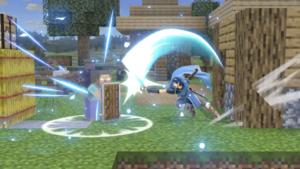
- In the EarthBound series there exists an ability known as Power Shield that can be used by using the PSI techniques PowerShield (in EarthBound Beginnings) and Shield and PSI Shields β or Ω (in EarthBound). Their function is to reflect attacks back to the owner, similar to how powershielding in Melee reflects projectiles.
- When performing a successful parry in Ultimate, the performer's portrait briefly shows the eye glint used in the pre-match splash screen. Additionally, the parrying fighter's eyes will glow, the same effect which occurs when a fighter is ready to use a Final Smash.
- Some fighters' perfect shields reference their original games aesthetically:
- Kirby's parry animation is taken from his Guard pose in Kirby Super Star.
- Wario's parry animation resembles both his official artwork from Super Mario Land 2 and a render from Wario World.
- Ryu and Ken's parry animations and their accompanying sound effect are taken from Street Fighter III: 3rd Strike.
- Dark Samus' parry animation references official artwork from Metroid Prime 3: Corruption.
- Banjo strikes a pose similar to the pose the Extra Lives depict him in, as well as an idle animation he can perform in Banjo-Kazooie: Nuts & Bolts.
- Terry's parry animation is his Just Defense Pose from Garou: Mark of the Wolves
- Steve uses a Shield from Minecraft to block the attack.
- Sora's parry animation is the pose he makes while using Guard in Kingdom Hearts.
- If the Shadow Assist Trophy freezes a character during the perfect shield window, the character will automatically perfect shield an attack while frozen. The character will even remain intangible afterwards until being unfrozen.
